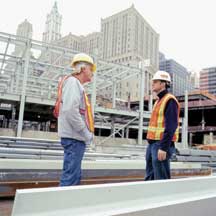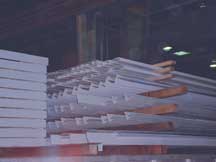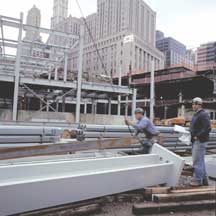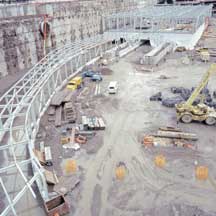A Symbol of Resolve
Although it may take years to complete the redesign and construction of new stations, tunnels and tracks for the train system that ran under the World Trade Center prior to the terrorist attacks in New York, many people are eager to get it up and running. But for the companies involved in the project to rebuild the infrastructure for the new train station at Ground Zero, the most important consideration was to have construction underway before the first anniversary of September 11.
"It was not just to boost everyone's morale," says Wayne Chilewski, project manager at Bridgewater Protective Coatings (Bridgewater, NJ), the company chosen to paint the 1,450 tons of steel beams and girders that would become the skeletal foundation of the new underground train station. "It was to show the rest of the world that we're not going to let anything stop us from going on and proceeding with our lives."
And on the company went, 24 hours per day, seven days per week, to get the job done. The project, which was unlike anything the company had attempted before in scope and size, was given a 15-week timetable.
"Getting the transportation lines back in service is critical," Chilewski says. The Port Authority Trans-Hudson (PATH) light-train system carries commuters between New York and New Jersey and is the main link for commuters between New Jersey and the Wall Street area.
The plans for this phase of the rebuilding efforts, which call for three tracks, a platform and underground station, are still being finalized. And although planners aren't yet sure what will rise above the station to replace the World Trade Center buildings, work is moving forward. The steel columns, which will stub off about a foot above the roof of the station, are designed to support all of the wide range of redevelopment options under consideration.
Onward and upward
But before anyone could begin, the usual paperwork trail had to be followed through city government and, in this case, the Port Authority of New York and New Jersey . Plans had to be made; designs had to be drawn up; project bids had to be taken and contracts awarded; lawyers and politicians had to be consulted.
But it was September 11 or bust. Canron Construction Corp. (Conklin, NY) was awarded the contract to provide the steal beams. The Port Authority placed the order in April 2002; deliveries to Bridgewater were to begin sometime in August. That was the plan. It would be a tight schedule.
Canron is a major fabricator and erector of structural steel for buildings and bridges in Canada, the United States and international markets. In the 1970s, Canron worked on 7 World Trade Center and three buildings in Battery Park City (28 acres of prime New York real estate formed by dumping the more than 1 million cubic yards of fill excavated at the WTC site into the Hudson, extending the shoreline), supplying and erecting 80,000 tons of steel. The company also built the World Financial Center atrium and completed repair of the Winter Garden in the spring of 2002.
Canron met its deadline for the beginning of steel shipments to Bridgewater Protective Coatings. The crews at Bridgewater then worked 12-hour shifts, and extra manpower was brought in. Truckloads of the steel beams and girders, which would require three coats of paint, moved in and out of the facility at more than twice the rate of any previous project. Coordinating the movement of cranes, trucks, people and product was taxing.
In the end, the hard work was worth the effort. When the dust had settled amid a collective sigh of relief, the daunting rush order had gone out without a hitch. Not only had deliveries of coated steel beams begun to arrive at the construction site in August, Bridgewater completed delivering all of the beams in less than eight weeks.
"We felt confident that we could get it done as fast as we did," Chilewski says. But he was surprised by the learning curve. "We thought it would take a week or so to get the coordination organized." In fact, the operation was running smoothly within the first two days.

Incoming
The steel beams would arrive at Bridgewater's facilities on flatbed trucks, which would usually pick up a load of painted steel beams for delivery to the construction site. There were more than 70 truckloads in all.The wide-flange I-beams are as wide as 30 inches and are from 3 feet to 57 feet long, weighing as much as 260 pounds per linear foot. "It's a pretty hefty beam," Chilewski says.
The beams were unloaded in an area of the facility that runs the length of the paint area by a 40,000-pound-capacity crane. The facility has two bays that are approximately 60 feet wide and 180 feet long.
The beams were then taken to an enclosed area in the facility where they were manually sandblasted to SP10 near white. SP10 is a degree of cleanliness established by the Steel Structures Painting Council; "near white" means that all visible residue is removed, with staining allowed to a maximum of 5% of each square inch.
Parts of the steel beams were masked and then moved to the painting area by crane. "Because of the type of equipment we paint here, be it structural steel or steel tanks, our entire facility is one big spray booth," Chilewski says. "There are filter systems throughout the entire building to eliminate fumes and overspray."
The filter system is a fairly standard series of exhaust blowers that are connected to ventilation stacks. The filters block paint and other particles from entering the blowers, and the air is released to the outside.
The facility is also environmentally controlled. Temperatures were always above 50°F and at least 5°F above the dew point. "This was critical to minimize the amount of cure time between each of the three coats of paint, to be able to handle the beams and, most critically, to load them onto the trucks without damaging the paint system," Chilewski says.
The three coats of paint include an organic zinc-rich primer, an epoxy intermediate coat and a high-solids polyurethane topcoat, all supplied by Sherwin-Williams (Cleveland). The beams required that the basecoat be between 3 and 5 mils thick after drying; the intermediate coat, 5 to 10 mils thick; and the topcoat, 3 to 4 mils thick. Thicknesses were tested with a Positest thickness gauge. Depending on the ambient temperature, each coat required about four hours to cure.

The paint equipment was mobile and moved from beam to beam. The paint had a pot life of four to six hours at 77°F, depending on the coating, but the paint was used up so quickly that pot life was never an issue.
A painting crew of two or three would begin with the primer coat and work its way among the beams. Several hours later, the next shift would begin where the first shift started, coating the beams with the intermediate epoxy coating.

"We were putting out about a truckload or more a day," he adds. "That includes offloading the truck, sandblasting, curing time and reloading the truck."

A degree of sophistication
The coating system has to be extremely durable because it will be underground where touchup is either not possible or not practical. But it also needed to be aesthetically pleasing, thus the need for three coats."The coatings were shop-applied because the Port Authority didn't want to have open spraying and have solvent fumes spread all over Manhattan," Chilewski says. "Most steel fabricators will spray, if they spray paint at all, a single component, like an alkyd primer. They are reluctant to approach multiple coats, and they are even more reluctant to approach multicomponent multicoat systems." Fabricators typically don't specialize in coating their products beyond a primer, generally don't have the necessary equipment and don't want to tie up floor space for the extra days necessary to coat products.
"These coatings," Chilewski adds, "particularly the zinc-rich primer, require a fair degree of sophistication to apply without having dry overspray or runs. It's somewhat temperamental unless you're used to using the product on a regular basis."
But the most difficult part of the project by far was the timing and coordination. If any part of the project-shipments, sandblasting, material handling, curing-particularly the curing, slowed down, bottlenecks could quickly have become a problem.
"Being able to keep all of these things moving steadily as efficiently as we did, that was an effort," Chilewski says. "We did bring in additional manpower. Coordinating that extra manpower was what made the project both difficult and interesting, but what ultimately made it successful."
What is more typical, Chilewski says, are small projects that last several days to a week or two. A few beams might be sandblasted and then put on the shop floor for painting. A painter would apply one coat of paint per day and then load the beams onto a truck the day after the last coat of paint dries.
Adding to the stress is the fact that these types of projects have very strict specifications and each beam is thoroughly inspected by BPC, as well as an outside contractor. The firm, KTA-Tator (Pittsburgh), monitored the coating process, checked the coating thickness and made sure the beams were properly loaded onto the trucks. The firm also monitored environmental conditions, including temperature, humidity, dust in the air and the temperature of the steel beams.
Chilewski and his crew will be involved in upcoming projects at the World Trade Center site when the details are finalized. Though the last project was difficult, Chilewski says he would do it all over again-"In a heartbeat."
Looking Back: The Port Authority and the WTC
The Port Authority of New York and New Jersey is an unusual organization with a colorful past. It's a government institution that heads up public projects in the New York and New Jersey port area. While the Port Authority is a public organization, it functions like a private corporation: It "charges" its customers directly and profits from investments rather than taking tax money.The reasons for the agency's creation can be traced to the accident of political history that divided a common port area between the two states. The states quarreled throughout the 19th century over their common harbor and waterways. A dispute over the boundary line through the harbor and the Hudson, finally settled by the Treaty of 1834, once led state police to exchange gunshots in the middle of the river.
Eventually the states found a governmental model for port management in the Port of London, which was then the only public authority in the world. In April 1921, The Port of New York Authority was established as the first of its kind in the Western Hemisphere and the first interstate agency created under a clause of the Constitution permitting compacts between states. One area of jurisdiction was called the "Port District," a bistate region of about 1,500 square miles centered on the Statue of Liberty. The name was changed to The Port Authority of New York and New Jersey in 1972 to identify more accurately its status as a bistate agency.
David Rockefeller, who initiated development of the World Trade Center in the 1950s, urged his brother, New York Governor Nelson Rockefeller, to get the Port Authority involved in the project. The agency became involved in 1960 and made its plans public in 1961.
Then things slowed down considerably. For years, the Port Authority slogged through fiscal problems, public relations debacles and legal wrangling, not to mention the unpopular task of evicting the hundreds of businesses and homes occupying the building site.
With all of the negotiations and logistical conflicts, excavation didn't actually start until 1966. By that time, the design and scope of the project had changed completely. The final design was a group effort, bringing together dozens of architects, structural engineers and managers, led by a few prominent talents.
It was not a popular project for many people. Besides the business owners and residents being forced out, citizens all over the city wondered why the Port Authority was sinking so much money into the project (the equivalent of $4.5 billion today), apparently at the expense of public transportation facilities; environmentalists questioned some of the construction practices; and several prominent architectural critics said the towers were simply too big and ostentatious. It would take some time for the city to accept and embrace the project.
But it eventually did. Officially opened on April 4, 1973, the Twin Towers alone required more than 200,000 tons of steel. If the current project at the WTC site ends up being anything like the original complex, it will keep companies like Canron and Bridgewater Protective Coatings (see main story) busy producing and painting steel for some time to come.
No one knows how long the current plans will take to accomplish or what feelings New York, and the nation, will eventually have for the site, but the journey will certainly be an emotional one for all involved.
Looking for a reprint of this article?
From high-res PDFs to custom plaques, order your copy today!







